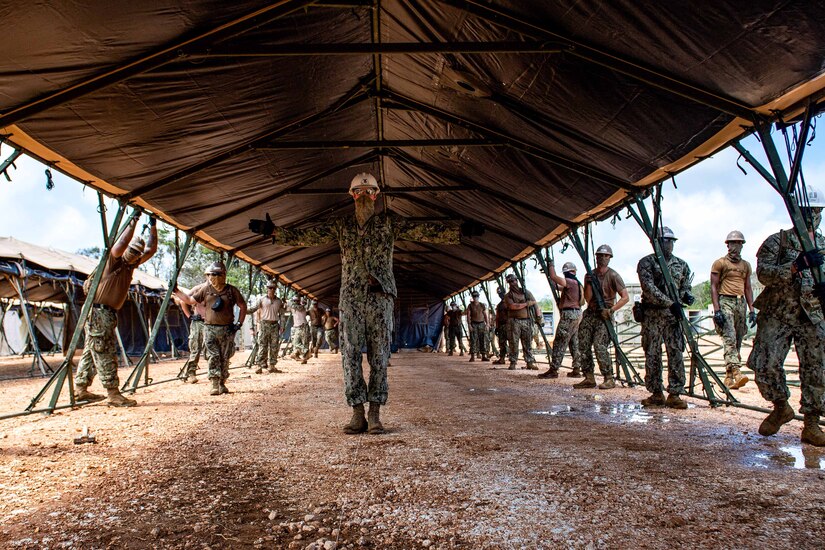May 4, 2020 | BY Navy Chief Petty Officer Matthew White
Sailors assigned to Task Force 75.5 achieved the engineering
initial operating capability of a 150-bed expeditionary medical facility as
part of the Defense Department's fight against COVID-19 on Naval Base Guam,
April 25.
Reaching engineering initial operating capability means the
medical facility is structurally ready to perform its core medical care mission
when medical staff arrives. Construction will continue until achieving full
operating capability, meaning the facility is fully constructed and able to
execute all of its designed tasks.
"The Seabees have been working hard through all the
adversities we've had out here to get this up and running as soon as
possible," said Navy Lt. Matthew Harms, the operations officer for Naval
Mobile Construction Battalion 1 Detachment Guam. "[They're] working
through the changing weather conditions — it rains two or three times a day and
is very hot and humid the rest of the time — on top of learning a brand new
tent system that most of our guys haven't seen before. But the team learned
quickly, and hasn't let anything get in the way of completing the EMF on time.
These guys are awesome."
With more than 130 Seabees working to build the facility,
construction began April 11 with the grading and leveling of the five-acre
site. Precise leveling and ground compaction is vital due to the sensitive
nature of the medical equipment.
"We started by knocking the ground down to a less than
2-percent slope," Harms said, "then built it back up, while
compacting the ground to make sure it was flat and stable for the facility."
Following ground preparation, the team began construction of
the facility's infrastructure April 20.
"The combined crew of [NMCB] 1 and [NMCB] 5 started
going through and building up the tents into 10 different wings that will make
up the medical core," Harms said. "There are also support sites that
are being built up for the EMF including fuel and water farms, a troop berthing
and hygiene area, and a galley. All of those are part of the expeditionary
medical facility and are required to support the approximately 400 medical and
support personnel that are coming in."
The Seabees were able to work as a cohesive unit due to the
technical guidance provided by sailors on the Expeditionary Medical Facility
Assist Team from Navy Expeditionary Medical Support Command and the Naval
Expeditionary Medical Training Institute.
"We have a lot of really motivated Seabees, and the
team from NEMTI, working for Guam and our brothers and sisters on the USS
Theodore Roosevelt," said Navy Petty Officer 1st Class Matthew Petree, a
quality control officer assigned to Navy Expeditionary Medical Training
Institute. "We build the EMF three or four times a year as training, and
we're happy to be able to come to Guam and put our experience to good
use."
The facility is a self-contained medical care facility,
enabling medical professionals to provide expanded medical capabilities, and
will enable forces to be postured to support the region if a Defense Support of
Civil Authorities mission is requested.
"It's a Role 3 [medical treatment facility], so you're
going to have all the capabilities of a hospital," Petree said.
"There are operating rooms, acute care wings, essential sterilization
capabilities, a medical lab and a pharmacy. It's really going to be able to do
everything you need."
Seabees building the facility are proud to be able to
contribute to the Defense Department's COVID-19 response in Guam.
"I think [building the EMF] is amazing," said Navy
Petty Officer 3rd Class Mark Austinweldon, a sailor assigned to Naval
Construction Battalion 1. "COVID is all around the world, and if this can
save anyone's life, I'm excited to be able to help."
Task Group 75.5 is led by the 30th Naval Construction
Regiment and is made up of personnel from Naval Construction Battalions 1 and
5, Construction Battalion Maintenance Unit 303, Naval Expeditionary Medical
Training Institute and Navy Expeditionary Medical Support Command.
As the command element of Task Group 75.5, the 30th Naval
Construction Regiment provides command and control over all Naval Construction
Force units in the 7th Fleet area of operations. It enables real-time mobility
of engineering units and other assigned forces to provide expeditionary,
general and limited combat engineer capabilities in response to major combat
operations and contingencies, theater security cooperation plan operations,
humanitarian assistance and disaster relief operations and civil-military
operations within the Indo-Pacific.
(Navy Chief Petty Officer Matthew White is assigned to
Commander Task Force 75.)

No comments:
Post a Comment